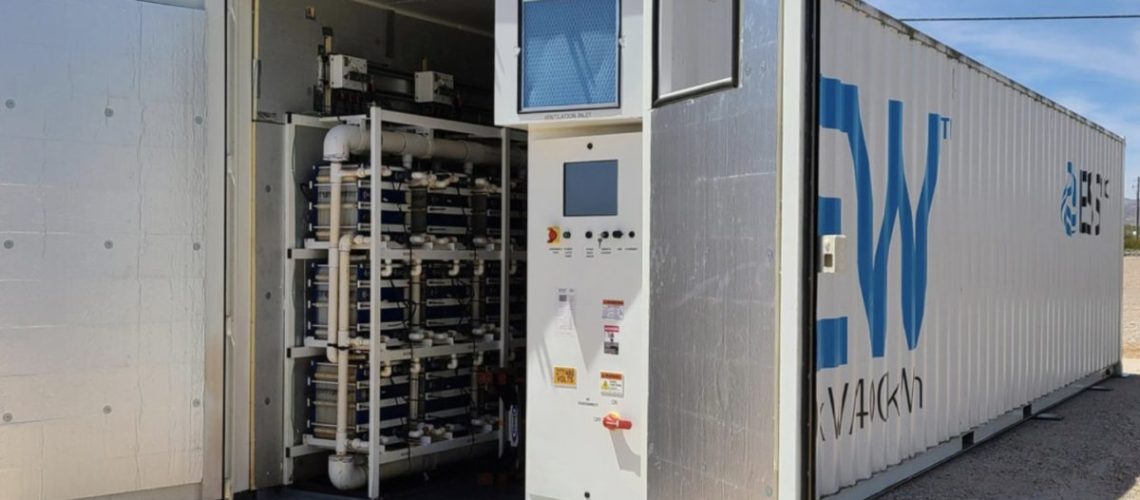The University of California, Merced has shown that up to 13 GW of solar capacity could be installed over California’s canals, which would require approximately 3 GW of energy storage.
A California water irrigation district launched Project Nexus, which is installing a 4 MW solar canopy on an irrigation canal in California. Today ESS Inc., a saltwater energy storage system manufacturer, announced the delivery of an Energy Warehouse system to the Turlock Irrigation District in Central California. The energy storage company will deploy a few Energy Warehouse containers to pair with solar panels over irrigation canals.
Project Nexus intends to generate clean energy while conserving water resources in an increasingly arid California environment.
The Energy Warehouse was selected for its safe and non-toxic characteristics, making it ideal for siting adjacent to water infrastructure. Funding for the Turlock project is provided by the State of California and administered by the Department of Water Resources.
The solar-plus-storage project will shade canals with solar panels, a process that will reduce evaporative losses while generating clean energy.
ESS will be exhibiting at Intersolar North America this week (Feb. 14 to 16) in Long Beach, Calif. The company will be demonstrating its long duration systems at booth #1031.
Recent research by the University of California, Merced shows the potential for 13 GW of solar capacity to be installed over California canals, which could necessitate about 3 GW of energy storage systems and contribute to the state’s clean energy and water conservation goals.
“This project addresses multiple climate challenges at once and is the kind of innovative approach that will build a climate-resilient future,” said Hugh McDermott, senior vice president, business development and sales at ESS. “We look forward to delivering a solution that can be replicated across California and other drought-prone areas.”
Turlock’s initial solar-plus-storage project is set to be complete in 2024. ESS’ iron flow technology provides long-duration energy storage and is designed for applications that require up to 12 hours of flexible energy capacity. The company reports that its non-toxic flow battery has a 25-year design life without capacity fade.
Long-duration storage systems of more than four-hour discharge are increasingly deployed in states with high solar penetration. After California, additional utility offtakers include NV Energy in Nevada, Georgia Power, Orlando Utilities Commission and Minnesota’s Great River Energy, Julia Souder, executive director of the Long Duration Energy Storage Council, told pv magazine USA in a recent interview.
According to BloombergNEF estimates, the federal Inflation Reduction Act is expected to drive an additional 6.6 GW / 26.4 GWh of new energy storage capacity in the California Independent System Operator (CAISO) market through 2030, even though Texas is forecast to add a higher amount of storage systems, at 8.9 GW / 35.6 GWh of additional capacity.
Unlike typical lithium-ion batteries that are packaged as fixed cells or modules, a flow battery such as the Energy Warehouse allows power to be decoupled from the capacity, allowing users the flexibility of using the battery for a variety of use cases simultaneously on a project.
The ESS warehouse container provides 400 kWh of peak energy in a module whose average life is more than 20,000 cycles. The container weighs 41.9 tons at wet weight and measures 40 feet by 8 feet, standing 9.5 feet high. The system uses recycled iron components and abundant saltwater, making its electrolyte system fully recyclable.
In August, ESS completed a microgrid system using the Energy Warehouse at an industrial recycling facility in West Grove, Penn. Developed by TerraSol Energies, a turnkey solar and storage developer, the system features the 75 kW / 300 kWh warehouse paired with a 115 kW DC solar array, creating a microgrid that reduces peak electricity demand and provides back-up power for Sycamore International, a recycling company.
Munich RE provides an industry-first ten-year insurance plan coverage for ESS battery storage systems regardless of project size or location.
Founded in 2011, Wilsonville, Ore.-based ESS has a $325 million market capitalization and will report its Q4 2022 and full year 2022 financial results on March 1, 2023 at 5:00pm EST. Interested parties can register for the call on the company’s investor relations website.



